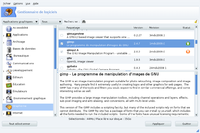Mandriva Linux
[5] Later on, the remaining developers teamed up with community members and formed OpenMandriva, a continuation of Mandriva.
[6] The first release of Mandrake was based on Red Hat Linux (version 5.1) and K Desktop Environment 1 in July 1998.
Mandrake included a number of original tools that make system configuration less difficult.
From its inception until the release of version 8.0, Mandrake named its flagship distribution Linux-Mandrake.
In February 2004, MandrakeSoft lost a court case against Hearst Corporation, owners of King Features Syndicate.
Hearst contended that MandrakeSoft infringed upon King Features' trademarked character Mandrake the Magician.
In April 2005, Mandrakesoft announced the corporate acquisition of Conectiva, a Brazilian-based company that produced a Linux distribution for Portuguese-speaking (Brazil) and Spanish-speaking Latin America.
It has many programs known as Drakes or Draks, collectively named drakxtools, to configure many different settings.
Mandriva Linux used a package manager called urpmi, which functions as a wrapper to the .rpm binaries.
It is also media-transparent due to its ability to retrieve packages from various media, including network/Internet, CD/DVD and local disk.
Urpmi also has an easy-to-use graphical front-end called rpmdrake, which is integrated into the Mandriva Control Center.
The latest stable version is Mandriva Linux 2011 ("Hydrogen"), released on 28 August 2011.
It was 'free' in both senses: it consists entirely of free and open-source software, and it was made available for public download at no charge.
Users could choose between different languages, select either the KDE or GNOME desktops and include or exclude non-free software.
It was also made available via a subscription service, which allowed unlimited downloads of Powerpack editions for the last few Mandriva releases for a set yearly fee.
In releases prior to Mandriva Linux 2007, Discovery was a 'traditional' distribution built on the DrakX installer.


